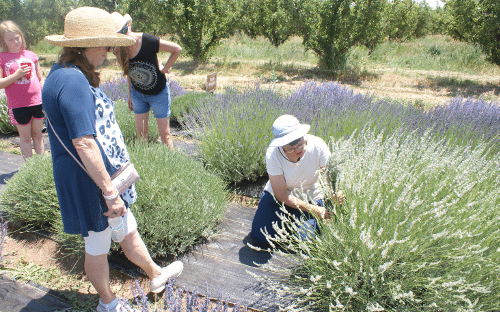
Question everything I say and seek further information if what I present raises questions in your mind. In a study from the Egyptian Journal of Horticulture, optimal yields of aerial parts of lavender were observed following fertilization with urea at 88 lb./ acre. The best yields of essential oil were observed following application of ammonium chloride (N source) at 44 lb/ acre (ElSherbany et al. 1997) Fertilizing is talked about in Lavender: The Grower’s Guide, The Lavender Lover’s Handbook and Dr. Swift’s excellent article Soil Preparation for Lavender.

I visited an organic lavender farm last summer. About a half-mile down the road I knew I was close, as I could smell the fragrance wafting through the air. The rolling hillside was full of stunning, silvery-green and purple lavender plants.

Lavender can be propagated by seed, layering or stem cuttings. We recommend using stem cuttings or layering because you can guarantee your new plants will not be a hybrid version caused by cross pollinating.

Sage Creations Organic Farm www.SageCreationsOrganicFarm.com 970‐623‐9556 TIP 1: Lavender needs full sun; a minimum of 6 to 8 hours. TIP 2: Lavender does not like “wet” feet, so give it a good soak and then let the plant go dry. If your soil is heavy and slow to drain, create a hospitable place for lavenders by […]

Those are hard words when you are afraid to cut too much or after watching all this growth happen in one summer to face knocking it all down. But pruning is what you must do for your lavender plants to thrive and live longer.

Lavender, an herb with many culinary uses, also makes a stunning addition to borders and perennial gardens, providing sweeping drifts of color from early summer into fall. With its silvery-green foliage, upright flower spikes and compact shrub-like form, lavender is ideal for creating informal hedges. You can also harvest it for fragrant floral arrangements, sachets, and potpourri.

In a 40-foot labyrinth, Susan Harrington grows 150 lavender plants. Harvesting 5-6 bundles per plant or approximately 700 bundles each flowering season offers some pretty fragrant returns. Susan and her husband Jack own Labyrinth Hill Lavender in Washington state.

There seems to be a lot of misconception about the effect altitude has on the ester content of lavender, and whether high altitude lavender is more desirable than lavenders grown at lower altitudes. It is not a simple answer, but I will try to provide the basic information about this issue.

Lavender, for many people throughout the West, is simply a decorative bush used in landscape designs. For Palisade peach farmer Ron Rish, it’s another source of income.

This Lavender Farm is Buzzing… It’s hard to say what catches the attention of a visitor first: the collective hum of hundreds of buzzing bees nestled in the stalks of 600 blooming lavender plants; or, the deep, vivid purple-hued plants themselves, gorgeously stretched out the length of an orchard, with cherry and peach trees along […]










